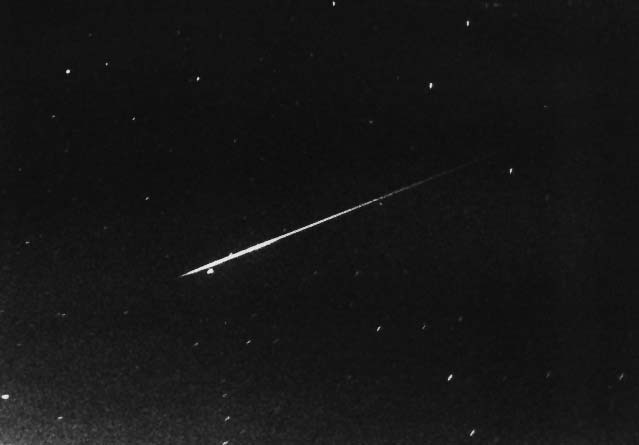

A Perseid Meteor (Photo courtesy of Michael Oates)
The Earth encounters thousands of tiny bits of meandering space debris (rock, sand) every day. The number, and perhaps the average size, of these particles increases sharply during meteor showers, but there is significant meteor activity almost every day. Upon entering the Earth's atmosphere, these particles burn up, leaving a heavily ionized trail. Although short lived, this ionized trail is capable of reflecting VHF signals momentarily. Meteor scatter if fairly reliable compared to many other VHF propatation modes. VHF operators know they can count on making meteor scatter contacts during several major meteor showers each year.
Meteor scatter propagation is good for working distances out to 1400 miles... perhaps further on rare occasions. It is comparatively easy at 50 MHz, becoming progressively more difficult at the higher bands. Burst duration becomes shorter as the frequency increases, and more intense ionization is needed (larger or faster moving meteors). At 50 MHz, 10 watts and a 4 or 5 element beam will net many contacts. At 144 MHz, better success will be had with 100 watts and a 15 foot boom yagi or more. At 432 MHz, high power and really good antennas will be needed.
Meteor scatter contacts are most often made by means of prearranged schedules, especially at the higher frequencies. In North America, SSB has been the prevalent mode, although this may be about to change as the European method of using High Speed CW for meteor scatter work is starting to catch on here as well. However, random (non scheduled) contacts are certainly possible on 50 and 144 MHz. Scheduled SSB contacts are made with 15 second transmit/receive sequencing, and a modified signal reporting system is used. A signal report generally consists of "S2". The idea is to pass callsigns, signal reports, and rogers during one or more brief bursts of signal. For random contacts, grid squares are often exchanged instead of reports. Antennas should generally be aimed toward the station one is trying to work, although path skewing of a few degress does occur at times. A "burst" occurs when a meteor enters the ionosphere about midway between two stations.
During major meteor showers, and in particular the Perseids in August, you may often get a single burst that is long enough to complete an entire contact (sometimes two or three contacts). Most of the time, though, calls are copied in one burst, signal reports some time later, etc. and the contact is pieced together bit by bit until all required information has been copied by both stations.
The optimum time of day for random (non-shower) meteors (NOTE: not random contacts, but random meteors) is in the morning, around daybreak. This is true because the rotation of the Earth increases the effective velocity of meteors heading into the Earth's path. For meteor showers, the peak time varies depending on the particluar shower and the direction one wishes to work.
Activity is usually highest during the better meteor showers: the Perseids, August 12 - 14; the Geminids, December 13-14; and the Quadrantids, January 3. However, contacts can be made on SSB almost any summer morning, and almost any day of the year using the European CW techniques.
There are several good computer programs for determining the optimum times for meteor scatter work. Check out the links below.
Meteor bursts occur suddenly, out of nowhere and can last from a fraction of a second to a minute or more, depending on frequency, meteor size and velocity. Faster (and larger) meteors produce longer bursts, stronger signals, and are usable higher in frequency.
Check out these links for more on meteor scatter:
![]() Make More Miles on VHF. Meteor scatter scheduling, links to software, etc. An excellent resource.
Make More Miles on VHF. Meteor scatter scheduling, links to software, etc. An excellent resource.
Here are some sounds of meteor scatter on the VHF bands.
![]() A 144 MHz CW meteor burst. This one is only a couple of seconds long. Notice how the signal
suddenly appears with no warning. Not much information gets through at this slow speed.
A 144 MHz CW meteor burst. This one is only a couple of seconds long. Notice how the signal
suddenly appears with no warning. Not much information gets through at this slow speed.
Provided by K0SM
![]() A typical 144 MHz SSB meteor burst. This one is only a few seconds long. Notice how the signal
suddenly appears with no warning, then slowly fades out again.
A typical 144 MHz SSB meteor burst. This one is only a few seconds long. Notice how the signal
suddenly appears with no warning, then slowly fades out again.
Provided by K0SM
![]() Another 144 MHz SSB meteor burst. This is what's known as a "blue whizzer". Again
the signal suddenly appears with no warning, but this one holds up for many seconds. The quiet spaces were during
K0SM's transmissions, which were not recorded. Note the call by WA5JCI at the end, after K0SM completes the contact
with WA3UUM. Sometimes the bursts are long enough for more than one contact.
Another 144 MHz SSB meteor burst. This is what's known as a "blue whizzer". Again
the signal suddenly appears with no warning, but this one holds up for many seconds. The quiet spaces were during
K0SM's transmissions, which were not recorded. Note the call by WA5JCI at the end, after K0SM completes the contact
with WA3UUM. Sometimes the bursts are long enough for more than one contact.
Provided by K0SM
![]()